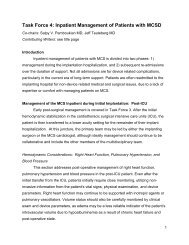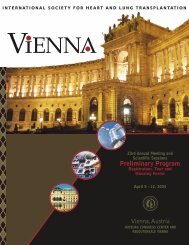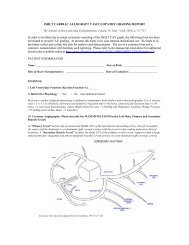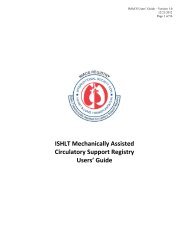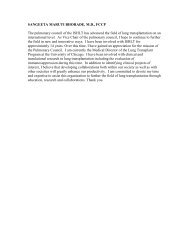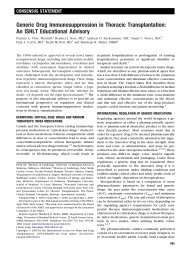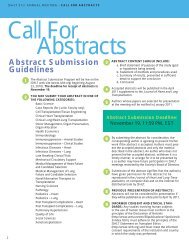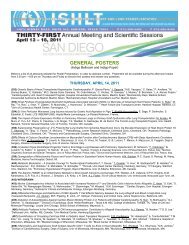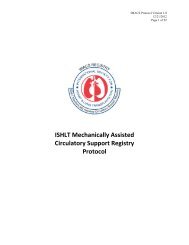Guidelines for the care of heart transplant recipients
Guidelines for the care of heart transplant recipients
Guidelines for the care of heart transplant recipients
Create successful ePaper yourself
Turn your PDF publications into a flip-book with our unique Google optimized e-Paper software.
Costanzo et al.<br />
<strong>Guidelines</strong> <strong>for</strong> Heart Transplant Care<br />
931<br />
Table 11 Suggested Dosing <strong>of</strong> Medications Used <strong>for</strong><br />
Treatment <strong>of</strong> Acute Cellular Rejection<br />
Medication Dose Duration<br />
Corticosteroids<br />
Methylprednisolone 250–1000 mg/day IV 3 days a<br />
(high-dose)<br />
Prednisone 1–3 mg/kg/day PO 3–5 days a<br />
Polyclonal anti-thymocyte<br />
antibody<br />
Thymoglobulin b 0.75–1.5 mg/kg/day 5–14 days<br />
ATGAM b 10 mg/kg/day 5–14 days<br />
ATG-Fresenius b 3 mg/kg/day 5–14 days<br />
Monoclonal antibody 5 mg/day 5–14 days<br />
Muromonoab-<br />
CD3 (OKT3) b<br />
ATG, anti-thymocyte gamma-globulin-fresenius; ATGAM, anti-thymocyte<br />
gamma-globulin; IV, intravenous; PO, oral (per os).<br />
a Corticosteroid taper can be considered.<br />
b Premedicate with CS, anti-histamine and anti-pyretic.<br />
Topic 4: Treatment <strong>of</strong> Acute Cellular Rejection<br />
Recommendations <strong>for</strong> Treatment <strong>of</strong> Symptomatic Acute<br />
Cellular Rejection 205–207,211–217 :<br />
(See Table 11)<br />
Class I:<br />
1. An EMB should be per<strong>for</strong>med as early as possible if<br />
<strong>the</strong>re is suspicion <strong>of</strong> symptomatic acute <strong>heart</strong> allograft<br />
rejection.<br />
Level <strong>of</strong> Evidence: C.<br />
2. The HT recipient with symptomatic acute cellular rejection<br />
should be hospitalized. Patients with hemodynamic<br />
compromise should be treated in <strong>the</strong> ICU.<br />
Level <strong>of</strong> Evidence: C.<br />
3. High-dose IV CS should be first-line <strong>the</strong>rapy <strong>for</strong> symptomatic<br />
acute cellular rejection irrespective <strong>of</strong> ISHLT<br />
EMB grade (1R, 2R or 3R).<br />
Level <strong>of</strong> Evidence: C.<br />
4. Cytolytic immunosuppressive <strong>the</strong>rapy with anti-thymocyte<br />
antibodies should be administered in addition to IV<br />
CS if hemodynamic compromise is present, and especially<br />
if <strong>the</strong>re is no clinical improvement within 12 to 24<br />
hours <strong>of</strong> IV CS administration.<br />
Level <strong>of</strong> Evidence: C.<br />
5. IV inotropes and vasopressors should be used as necessary<br />
to maintain adequate CO and systemic blood<br />
pressure until recovery <strong>of</strong> <strong>heart</strong> allograft function occurs.<br />
Level <strong>of</strong> Evidence: C.<br />
6. Anti-microbial prophylaxis against opportunistic infections<br />
should be administered when high-dose CS<br />
and/or cytolytic <strong>the</strong>rapy are used <strong>for</strong> <strong>the</strong> treatment <strong>of</strong><br />
rejection.<br />
Level <strong>of</strong> Evidence: C.<br />
7. Appropriate adjustments <strong>of</strong> maintenance immunosuppressive<br />
<strong>the</strong>rapy should be made to decrease <strong>the</strong> risk<br />
<strong>of</strong> recurrent rejection. These can include ascertainment<br />
<strong>of</strong> compliance with current <strong>the</strong>rapy, increase in<br />
<strong>the</strong> dose <strong>of</strong> current immunosuppressive agent(s), addition<br />
<strong>of</strong> new agent(s), or conversion to different<br />
agent(s).<br />
Level <strong>of</strong> Evidence: C.<br />
8. Follow-up EMB should be done 1 to 2 weeks after<br />
initiation <strong>of</strong> <strong>the</strong>rapy <strong>for</strong> acute cellular rejection.<br />
Level <strong>of</strong> Evidence: C.<br />
9. Serial echocardiograms should be used to monitor<br />
changes in <strong>heart</strong> allograft function in response to antirejection<br />
<strong>the</strong>rapy.<br />
Level <strong>of</strong> Evidence: C.<br />
10. In a patient with low-grade acute cellular rejection and<br />
hemodynamic compromise, <strong>the</strong> possibility <strong>of</strong> AMR<br />
should also be entertained (see AMR section).<br />
Level <strong>of</strong> Evidence: C.<br />
11. Interleukin-2 receptor blockers should not be used to<br />
reverse acute cellular rejection.<br />
Level <strong>of</strong> Evidence: C.<br />
Recommendations <strong>for</strong> <strong>the</strong> Treatment <strong>of</strong> Asymptomatic<br />
Acute Cellular Rejection: 205–207,211–217<br />
Class I:<br />
1. Severe acute cellular rejection (ISHLT 3R) diagnosed<br />
by surveillance EMB should be treated even in <strong>the</strong><br />
absence <strong>of</strong> symptoms or evidence <strong>of</strong> <strong>heart</strong> allograft<br />
dysfunction.<br />
Level <strong>of</strong> Evidence: C.<br />
2. High dose IV CS should be given <strong>for</strong> asymptomatic<br />
severe (ISHLT 3R) acute cellular rejection.<br />
Level <strong>of</strong> Evidence: C.<br />
3. Asymptomatic moderate acute cellular rejection (ISHLT<br />
2R) can be treated with ei<strong>the</strong>r IV or oral CS.<br />
Level <strong>of</strong> Evidence: C.<br />
4. Adjustment <strong>of</strong> maintenance immunosuppressive <strong>the</strong>rapy<br />
should be done in patients with asymptomatic moderate<br />
(ISHLT 2R) or severe (ISHLT 3R) acute cellular rejection.<br />
This can include an increase <strong>of</strong> <strong>the</strong> dose <strong>of</strong> current<br />
medications, addition <strong>of</strong> an agent, or conversion to a<br />
different maintenance regimen.<br />
Level <strong>of</strong> Evidence: C.<br />
5. Anti-microbial prophylaxis against opportunistic infections<br />
should be administered when high-dose CSs and/or<br />
cytolytic <strong>the</strong>rapy are used <strong>for</strong> treatment <strong>of</strong> rejection..<br />
Level <strong>of</strong> Evidence: C.<br />
Class IIa:<br />
1. The per<strong>for</strong>mance <strong>of</strong> a follow-up EMB should be considered<br />
2 to 4 weeks after initiation <strong>of</strong> <strong>the</strong>rapy <strong>for</strong> asymptomatic<br />
moderate or severe acute cellular rejection.<br />
Level <strong>of</strong> Evidence: C.<br />
2. Cytolytic immunosuppressive <strong>the</strong>rapy can be considered<br />
if <strong>the</strong>re is no histologic resolution <strong>of</strong> rejection on <strong>the</strong><br />
follow-up EMB.<br />
Level <strong>of</strong> Evidence: C.



